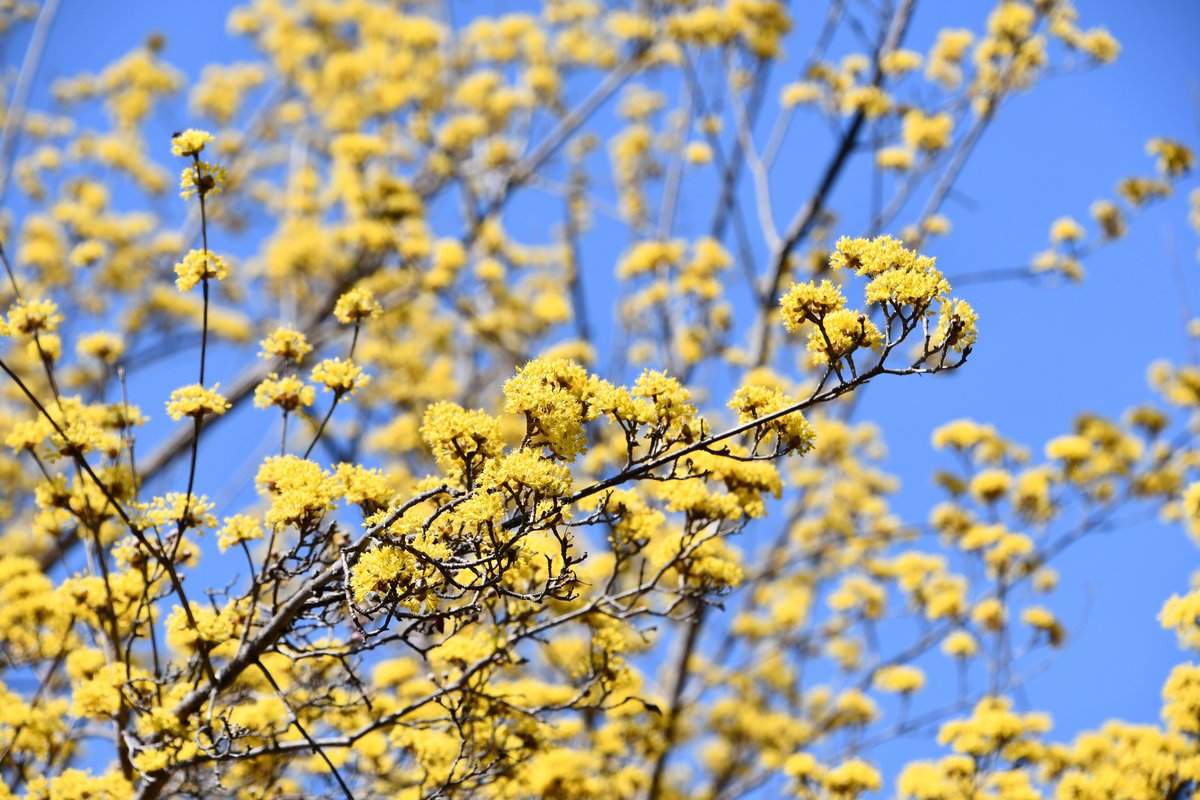
春に焦がれるハルコガネバナ
今週は真冬に逆戻りしたような寒さですね。皆さん、風邪などひいていませんでしょうか?昨日たまたまいた西東京で、晴れていたにもかかわらず雪がちらついていました。
三寒四温、とはよく言ったもの。
三日間くらい寒い日が続いた後に、四日間ほど暖かい日がやって来る、そうしてだんだんと暖かい日が増えて春に近づいていく、というこの時期の気候を表す言葉ですが、今週の真冬並みの寒さの中でも着実に春を予感させる植物が開花しています。
本日の主役、サンシュユです。
黄色の花を枝いっぱいに咲かせ、春の訪れを知らせてくれるサンシュユ(山茱萸)。一般的な開花時期は3月〜4月なのですが、市場ではもうすでに出回っていて、春めいた雰囲気を漂わせています。

原産は、中国、朝鮮半島。日本へは江戸時代中期に薬用植物として入ってきました。7、8メートルほどまで成長するので、庭木というより、公園や街路樹向きかな。ですが、広いお庭を持っている方は、ぜひお一ついかがでしょう。というのも、サンシュユは、秋に真っ赤なグミのような偽果をつけるのですが、この実のタネを取り除いて乾燥させたものは、古くから滋養強
壮、疲労回復などの生薬として重宝されてきました。実をお酒につけて、果実酒としても◎。
冷え性、頻尿、血糖値を下げる作用や免疫力を向上させる作用があるので、「老化防止の漢方薬」と言われてきたそう。自宅で育てて、春は花を愛で、秋は実を楽しみ、採取して自家製生薬果実酒を作ったりしたら、この植物をたっぷりと味わえて楽しそう!
先週末に台湾茶のプロの方とコラボして、台湾茶といけばなの講座をしてきたのですが、その時の花材としてサンシュユを使いました(instagram:@ichirin_naokoでぜひ検索して講座の様子を見てください)。その際、サンシュユが中国語の音読みから来ていることを話し、ご存じの植物かと尋ねてみたら、「漢詩に確かその名の植物が出てきた記憶がありますが、秋の詩だったと思います」とおっしゃっていました。つまり、中国で「サンシュユ」と言えば、赤い実をたわわにつけた枝、漢方薬としても役立つ秋の植物、のイメージなのでしょう。いけばなのイメージでは、早春の花として、黄色の花をつけている今の時期のサンシュユがメインなのですけどね。ところ変われば、ということなのか、あるいは個人の経験値によるものなのか。面白いなあ、と思いました。
さらにおもしろい情報が。サンシュユは、ブルガリアで「ヨーグルトの木」と呼ばれるドリャンという木の親戚だと!なんでも、40℃に温めた牛乳にサンシュユの枝を入れて一晩保温して置くと、翌日にヨーグルトが出来上がるというのです。サンシュユの枝には乳酸菌があるからなのだそう。面白そうなのでやってみようかな。だけど、温かい牛乳の状態を一晩保つのも難しそうですし、できたとしても、安心して食べられるのか?・・・疑問ではありますが。笑
いけばな教室のお稽古と、台湾茶とのコラボ講座で使いきれなかったサンシュユが、今自宅で満開に開花しています。ミモザとはまた違う味のある花の様子で、これまた本当に可愛い。牧野富太郎は、この植物に和名をつけたくて、「ハルコガネバナ(春黄金花)」と名付けました。春を焦がれる花、とも聞こえるような音の響き。この和名、素敵だと思いませんか?
サンシュユの花言葉は、「持続」。
生薬の効き目からついた花言葉。三寒四温で体調も自律神経も乱れがちな時期の今こそ、サンシュユを求めに一度漢方薬局を覗いてみるのも良いかもしれませんね。
【編集後記】
うさぎのマメちゃんが、6歳になりました。人間で言うと、還暦。うさシニアの仲間入りです。まだまだ食欲旺盛で毛の艶もグッド。これからもなるべく元気で健やかな毎日を過ごせるように願っています。
This week feels as if we've returned to midwinter. How is everyone? I hope you're not catching a cold. Yesterday, even though it was sunny in Nishitokyo where I happened to be, I saw some snowflakes falling.
【Ichirin's Bud Vase 🌸 Harukogane-bana, the Flower Longing for Spring】
"Three cold days and four warm days" is a saying that aptly describes this season's climate. After about three days of cold weather, four days of warmth follow, gradually increasing the warm days as we approach spring. Even amidst this week's midwinter-like chill, plants that herald spring are beginning to bloom.
Today's main feature is the Sanshuyu. With its branches full of yellow flowers, the Sanshuyu (Cornus officinalis) announces the arrival of spring. Typically, it blooms from March to April, but it's already appearing in markets, bringing a touch of spring ambiance.

Originally from China and the Korean Peninsula, Sanshuyu was introduced to Japan in the mid-Edo period as a medicinal plant. It can grow up to 7 or 8 meters tall, making it more suitable for parks or as street trees rather than garden plants. However, if you have a spacious garden, why not consider planting one? In autumn, it bears bright red, gumi-like fruits. When the seeds are removed and the flesh dried, these fruits have long been valued as a herbal medicine for nourishing and revitalizing the body. You can also infuse the fruits in alcohol to make fruit wine. Known to alleviate cold sensitivity, frequent urination, lower blood sugar levels, and boost immunity, it's been referred to as an "anti-aging herbal medicine." Growing it at home allows you to enjoy its flowers in spring and its fruits in autumn, and even make your own herbal fruit wine—what a delightful way to fully appreciate this plant!
Last weekend, I collaborated with a Taiwanese tea expert to conduct a workshop combining Taiwanese tea and ikebana. We used Sanshuyu as one of the materials (please check out the workshop photos on Instagram: @ichirin_naoko). During the session, I mentioned that the name "Sanshuyu" comes from the Chinese pronunciation and asked if they were familiar with the plant. They responded, "I recall this plant being mentioned in Chinese poetry, probably in autumn-themed poems." In China, "Sanshuyu" evokes images of branches laden with red fruits, associated with autumn and valued as a herbal medicine. In ikebana, however, we focus on the early spring aspect, highlighting the yellow flowers of the current season's Sanshuyu. It's fascinating how perceptions vary depending on the region or individual experiences.
Here's another interesting tidbit: Sanshuyu is related to a tree called "Duryan," known as the "yogurt tree" in Bulgaria. It's said that if you place a branch of Sanshuyu into warmed milk (about 40°C) and keep it warm overnight, it turns into yogurt by the next day. This is because the branches contain lactic acid bacteria. It sounds intriguing, and I might give it a try. However, maintaining the milk at a warm temperature overnight seems challenging, and even if it works, I'm not sure if it's safe to eat... Quite the conundrum. (laughs)
The leftover Sanshuyu from our ikebana classes and the Taiwanese tea collaboration is now in full bloom at my home. Unlike mimosa, it has a unique charm that's truly endearing. Tomitaro Makino, eager to give this plant a Japanese name, called it "Harukogane-bana" (春黄金花), which translates to "spring golden flower." The name resonates with a sense of longing for spring. Isn't this Japanese name just lovely?
The flower language of Sanshuyu is "endurance." This stems from the efficacy of its fruit as a herbal medicine. In this period of fluctuating temperatures, which can disrupt our health and autonomic nerves, perhaps it's worth visiting a herbal pharmacy to seek out some Sanshuyu.
【Editor's Note🥀】
My rabbit, Mame-chan, has turned 6 years old. In human terms, that's equivalent to 60 years—a milestone age. She's now a senior bunny. Still, she has a hearty appetite and a glossy coat. I hope she continues to live each day in good health and happiness.
🌿🌿🌿🌿🌿🌿🌿🌿🌿🌿🌿🌿🌿🌿🌿🌿🌿🌿🌿🌿🌿🌿🌿🌿🌿🌿🌿🌿🌿🌿🌿🌿🌿🌿
ichirinフラワーアレンジメントスクール・龍生派一綸いけばな教室 受講者募集中!
いずれもオンラインレッスン・対面レッスンがあります。
フラワーアレンジメント教室は、「ウェルカムリースの会」として、リニューアルしました!季節のお花を楽しむ会なので、興味のある回に単発で参加も可能です。

いけばな教室はコース仕立てなので、効率的・計画的に実力をつけていけます。龍生派のお免状も取得できるいけばな専門のコースです。(対面6,000円、オンライン9,000円/回)また、自分のペースでのんびり学びたいという方ももちろんOK!(月に1回〜)。お気軽に体験レッスンもできます。

一綸いけばな教室のウェブサイトは以下のリンクからご覧いただけます。
https://ichirin-ikebana.com/
🌿🌿🌿🌿🌿🌿🌿🌿🌿🌿🌿🌿🌿🌿🌿🌿🌿🌿🌿🌿🌿🌿🌿🌿🌿🌿🌿🌿🌿🌿🌿🌿🌿🌿
ichirin代表大澤尚子の活動情報はこちら。
・ichirinウェルカムリースの会
・ネットショップ:ichirin’s STORE
・Instagram(アレンジメント、リース、スワッグ):ichirin (@hanasakka.ichirin)
・Instagram(いけばな):大澤 尚子 (@ichirin_naoko)

